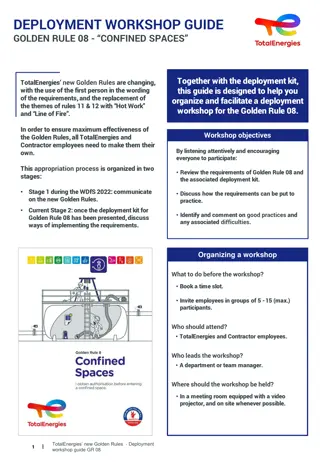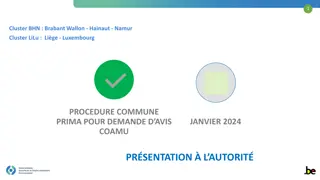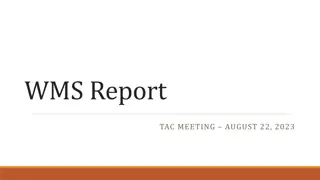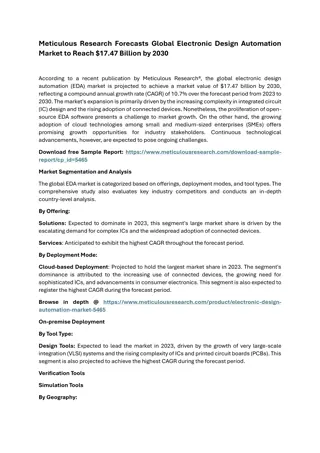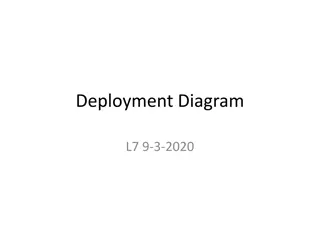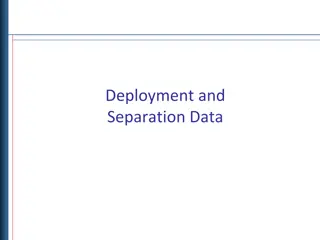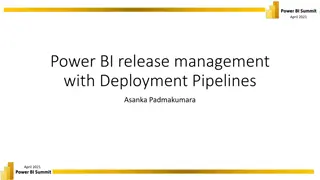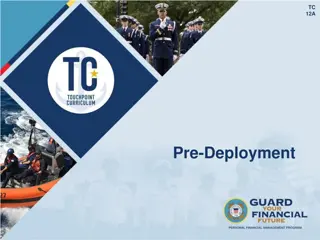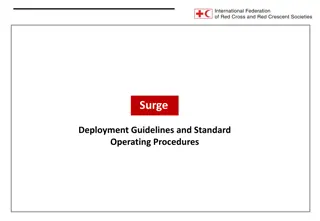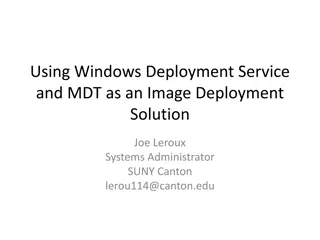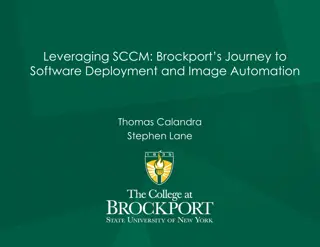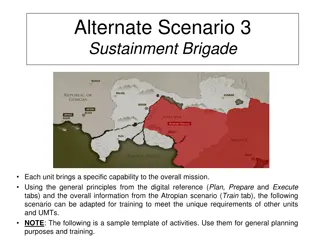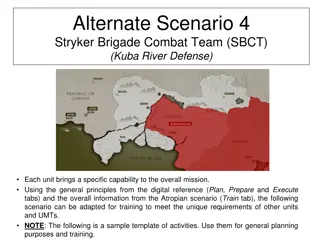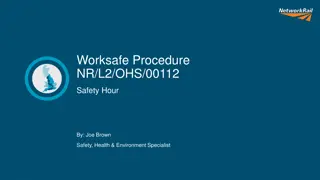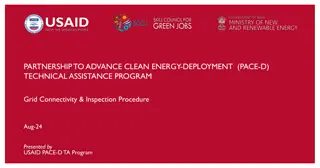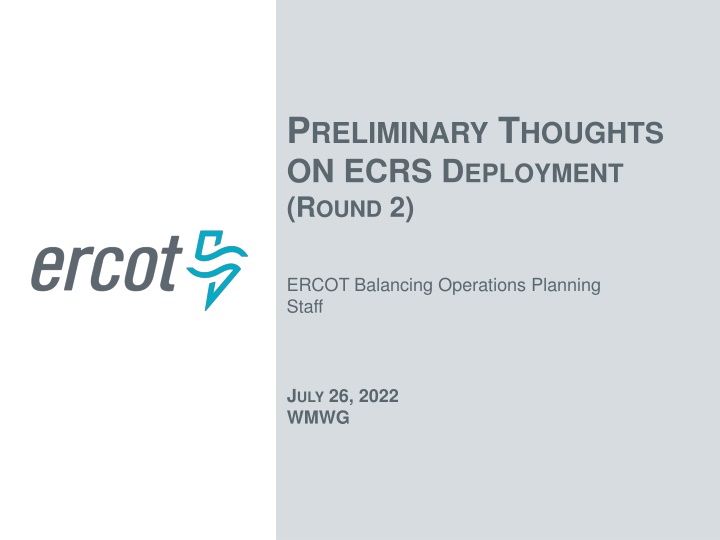
ERCOT Contingency Reserve Service Deployment Insights
Explore the deployment strategies of ERCOT's Contingency Reserve Service (ECRS) based on frequency deviation and net load ramps. Understand the conditions and triggers for deploying ECRS to maintain grid stability and restore frequency levels effectively.
Download Presentation

Please find below an Image/Link to download the presentation.
The content on the website is provided AS IS for your information and personal use only. It may not be sold, licensed, or shared on other websites without obtaining consent from the author. If you encounter any issues during the download, it is possible that the publisher has removed the file from their server.
You are allowed to download the files provided on this website for personal or commercial use, subject to the condition that they are used lawfully. All files are the property of their respective owners.
The content on the website is provided AS IS for your information and personal use only. It may not be sold, licensed, or shared on other websites without obtaining consent from the author.
E N D
Presentation Transcript
PRELIMINARY THOUGHTS ON ECRS DEPLOYMENT (ROUND 2) ERCOT Balancing Operations Planning Staff JULY 26, 2022 WMWG
Background on ECRS ERCOT Contingency Reserve Service (ECRS) is a service that is provided using capacity that can be sustained at a specified level for two consecutive hours and is used to restore or maintain the frequency of the ERCOT System: a) In response to significant depletion of RRS; b) Upon detection of insufficient capacity for net load ramps during periodic checking of available capacity. c) As backup Regulation Service; d) By providing energy to avoid getting into or during an Energy Emergency Alert (EEA); and This presentation will build on the preliminary thoughts ERCOT shared on the various conditions that can lead to deployment of ECRS at WMWG s June 2022 meeting. Specifically, this presentation will focus on conditions for deployment of ECRS from SCED dispatchable Resources (ECRS-Gen). This presentation will also introduce the preliminary approach ERCOT is considering to establish ECRS requirements. 2 PUBLIC 2
ECRS deployment based on Frequency deviation Following large unit trips or other large frequency deviation, ECRS-Gen will be deployed to replenish the deployed RRS or Regulation Up (Reg-Up). Specifically, EMS s LFC will, Release all or partial capacity of ECRS-Gen to respond to a frequency deviation when the power requirement to restore frequency to normal exceeds available Reg-Up. Reserved for frequency response Frequency Deviation Frequency Bias RequestedMW Deployment Reserved for large netload ramp Recall the deployed ECRS-Gen when the frequency is restored above 59.98 Hz 3 PUBLIC 3
ECRS deployment based on Net Load ramps ECRS may also be deployed to respond to a large, sustained, rapidly increasing net-load up ramp event. Scenario 2 Scenario 1 OFFLINE Non-Spin 10 minutes 30 minutes Scenario 1: Reg-Up is exhausted and Net Load continues to grow. There is shortage in the available capacity to SCED within 30 minutes, i.e., OFFLINE Non-Spin Deploy Trigger < 0 MW, Offline Non-Spin may be deployed partially or entirely. If the magnitude of Net Load increase exceeds the amount of available OFFLINE Non-Spin, deployment of ECRS-Gen will provide more capacity to SCED. Scenario 2: If the grid experiences a ramp issue for the incoming large 10-min Net Load change, deployment of ECRS-Gen will avoid exhausting Reg-Up. 4 PUBLIC 4
ECRS deployment based on Net Load ramps To respond to issues related to net load ramps, ERCOT is considering the following two triggers to decide when ECRS-gen deployment may be needed 1. Trigger 1 : (PRC 3200 MW) (projected 10min Net Load ramp) + Remaining QSGR capacity < X MW Designed to trigger ECRS deployment before Non-Spin (@PRC = 3200 MW). ECRS will be deployed either when PRC is low or the projected 10min Net Load ramp reduce PRC below 3200 MW Remaining QSGR capacity helps account for the capacity that is not frequency responsive and is able to respond within 10min (i.e. QSGRs in OFFQS not carrying A/S plus QSGRs in OFF). Through this approach, deployment of ECRS can 1) provide OFFLINE Non-Spin more time to be fully deployed or 2) prevent the grid from entering Advisory if ECRS amount if sufficient. 2. Trigger 2: (10min ramp capacity) (projected 10min Net Load ramp) < 0 MW ECRS will be deployed when there is lack of 10min ramping capacity. Note that, in situations where ECRS-Gen is deployed for Net Load ramps, Non-Spin deployment may also be needed to recover the deployed ECRS. 5 PUBLIC 5
Trigger 1 - July 13, 2022 *Triggers for OFFLINE Non-Spin Deployment: (1) (High Ancillary Service Limit (HASL) Gen Intermittent Renewable Resource (IRR) Curtailment) (30-minute net load ramp) < 0 MW (2) Physical Responsive Capability (PRC) < 3200 MW and not expected to recover within 30 minutes without deploying reserves 6 PUBLIC 6
Trigger 2: July 13, 2022 *Triggers for OFFLINE Non-Spin Deployment: (1) (High Ancillary Service Limit (HASL) Gen Intermittent Renewable Resource (IRR) Curtailment) (30-minute net load ramp) < 0 MW (2) Physical Responsive Capability (PRC) < 3200 MW and not expected to recover within 30 minutes without deploying reserves 7 PUBLIC 7
Trigger 1 - July 8, 2022 8 PUBLIC 8
Trigger 1: Jan thru May 2022 Observed a shortage of about 200 MW on May 13, 2022 only. On May 13, 2022, about 800 MW of Offline Non-spin was deployed. 9 PUBLIC 9
Trigger 2: Jan thru May 2022 There were 187 minutes when the trigger became negative (the maximum shortage is about 1500 MW). Observed a maximum shortage of ~1200 MW and ~600 MW for April 10 and May 13, respectively. 10 PUBLIC 10
Summary & Next Steps ECRS-Gen i.e. ECRS from SCED Dispatchable Resources may be deployed a) automatically when frequency drops below 59.91 Hz and available Reg-Up is not sufficient to restore frequency AND/OR b) manually in response to a large, sustained, rapidly increasing net-load up ramp event. Both triggers for manual deployment of ECRS-Gen have been designed to identify times when there is a potential for reliability issues due to sustained net load up ramps. Both triggers use 10-min Net Load forecast and these triggers are vulnerable to misses if 10-min out Net Load ramp forecast is under-estimated. a) ERCOT will continue to improve the forecast performance in the 10 min horizon. b) May need to consider some margin in the two triggers to protect against the expected, normal forecast errors. As work on implementing ECRS in ERCOT systems progresses, ERCOT may further refine the procedure for ECRS deployment. Going forward, ERCOT plans to include a document that summarizes the procedure for ECRS deployment in the A/S Methodology posting. 11 PUBLIC 11
APPENDIX PUBLIC 12 12
ECRS DEPLOYMENT PROCEDURE PRELIMINARY THOUGHTS ERCOT Balancing Operations Planning Staff JUNE 17, 2022 WMWG
Background on ECRS ERCOT Contingency Reserve Service (ECRS) is a service that is provided using capacity that can be sustained at a specified level for two consecutive hours and is used to restore or maintain the frequency of the ERCOT System: a) In response to significant depletion of RRS; b) As backup Regulation Service; c) By providing energy to avoid getting into or during an Energy Emergency Alert (EEA); and d) Upon detection of insufficient capacity for net load ramps during periodic checking of available capacity. This presentation will share ERCOT s preliminary thoughts on deployment procedure for ECRS. 14 PUBLIC 14
ECRS Deployment/Release Introduction There are four situations that will cause ECRS to be deployed: Disturbance conditions such as a unit trip, sustained frequency decay or sustained low frequency operations; Detection of insufficient capacity for net load ramps during periodic checking of available capacity; SCED not having enough energy available; or When Resource(s) providing ECRS are the only reasonable option(s) available to the Operator for resolving local issues. In each of these cases, the ERCOT operator will make the final decision and initiate the deployment. The ERCOT operator shall deploy ECRS in amounts sufficient to respond to the operational circumstances. This means that ECRS may be deployed partially over time or may be deployed in its entirety. To the extent that ERCOT deploys a Non-Controllable Load Resource that has chosen a block deployment option, ERCOT shall either deploy the entire Ancillary Service Resource Responsibility or, if only partial deployment is possible, skip the Load Resource with the block deployment option and proceed to deploy the next available Resource. 15 PUBLIC 15
ECRS Deployment/Release Conditions ERCOT will deploy ECRS when frequency drops below 59.91 Hz and available Reg-Up is not sufficient to restore frequency. ERCOT may deploy ECRS under the following conditions, When (Physical Responsive Capability (PRC) 3200 (10-minute net load ramp) < X MW, deploy sufficient ECRS capacity so that (HASL Gen IRR Curtailment) (30-minute net load ramp) > Y MW.* When (Physical Responsive Capability (PRC) 3200 (10-minute net load ramp) < Z MW, deploy all ECRS capacity.* Non-Controllable Load Resources that are providing ECRS will be separated into deployment groups as defined in Nodal Protocol Section 6.5.9.4.2 EEA Levels paragraph (2). Non-Controllable Load Resources that are providing ECRS can be deployed during an Emergency Condition either individually, in groups, or as an entire block providing Non-Spin. Deployments that do not encompass an entire block may be done to manage inertia, congestion, or for other local needs. If a condition other than those listed above indicates that additional capacity may be needed to manage reliability, operators will evaluate the system condition and deploy ECRS as needed if no other better options are available to resolve the system condition. Under emergency, the emergency process will govern the deployment of ECRS. *This is a preliminary metric that ERCOT is considering to use to identify when ECRS on SCED Dispatchable resources may be deployed. 16 PUBLIC 16
ECRS Deployment & Recall Steps SCED Dispatchable Resources SCED dispatchable Generation Resources (including Quick Start Generation Resources) & Controllable Load Resources that are providing ECRS (Automatic and Manual Deployment) Upon receiving an ECRS deployment instruction via ICCP, the QSE shall adjust the telemetered ECRS Ancillary Service Schedule for the SCED dispatchable Resources. ERCOT will automatically calculate new HASL constraints for SCED using the telemetry of the Resource s ECRS Ancillary Service Schedule. The QSE must, at a minimum, ensure that the Emergency Ramp Rate represented by the Resource s ramp rate curve is sufficient to allow SCED to fully Dispatch the Resource s ECRS Resource Responsibility within 10 minutes. QSEs can restore ECRS Ancillary Service Schedule once the ICCP Deployment signal reflects zero MW ECRS deployment. 17 PUBLIC 17
ECRS Deployment & Recall Steps Generation Resources operating in Synchronous Condenser mode Generation Resources operating in synchronous condenser fast response mode using Resource Status ONECRS ERCOT will deploy and recall Generation Resources operating in synchronous condenser fast response mode carrying ECRS (ONECRS) using ICCP Deployment instruction that is separate from other ECRS Deployment instruction for other SCED dispatchable resources providing ECRS. ONECRS resources may be deployed automatically when frequency falls below 59.80 Hz or manually (A) to meet NERC Standard defined in Nodal Protocol Section 6.5.7.6.2.4 (2) OR (B) during scarcity conditions following declaration of an EEA Nodal Protocol Section 6.5.7.6.2.4 (5). Automatic Deployment and Recall Automatic deployment based on Frequency threshold of 59.80 Hz Full response must be provided in 20 seconds When Frequency hits 59.80 Hz, ERCOT will follow-up with the ONECRS ICCP Deployment Instructions that equals the current ECRS Ancillary Service Responsibility of Resources telemetering Resource Status of ONECRS. ERCOT expects automatic response and QSE should only use the ONECRS ICCP Deployment instructions for maintaining Resources output to match the ONECRS ICCP Deployment instruction. Following the recovery of system frequency (currently 59.98 Hz), and ERCOT not under an EEA, ERCOT will reset the ONECRS ICCP Deployment signal to reflect a zero MW ECRS deployment. QSEs can restore ONECRS capability and stop generating MW from ONECRS Resources once the ONECRS ICCP Deployment signal reflects zero MW ECRS deployment. 18 PUBLIC 18
ECRS Deployment & Recall Steps Generation Resources operating in Synchronous Condenser mode Manual Deployment and Recall under EEA Condition Generally, manual deployment of Resources telemetering Resource Status of ONECRS will happen following declaration of an EEA Level 1 but before ERCOT enters into EEA level 2. When ERCOT declares EEA Level 2 or EEA Level 3 without declaring EEA level 1, ERCOT may immediately deploy ONSC Resources. Manual deployment instructions equal to ECRS Ancillary Service Responsibility will be sent through ICCP to deploy all available ECRS MW capacity from Generation Resources providing ECRS that have a Resource Status of ONECRS. QSEs will have 10 minutes following the receipt of ERCOT deployment instructions to provide energy deployments from Generation Resources providing ECRS that have a Resource Status of ONECRS. Following the recovery of PRC above 2500 MW and stable system frequency, ERCOT will reset the ONECRS ICCP Deployment signal to reflect zero MW deployment. QSEs can then restore ONECRS capability and stop generating MW from ONECRS Resources. Manual Deployment and Recall under non-EEA Condition Manual deployment instructions totaling QSEs ECRS Ancillary Service Responsibility will be sent through ICCP to deploy all available ECRS MW capacity from Generation Resources providing ECRS that have a Resource Status of ONECRS. QSEs will have 10 minutes following the receipt of ERCOT deployment instructions to provide energy deployments from Generation Resources providing ECRS that have a Resource Status of ONECRS. Following the recovery of system frequency (currently 59.98 Hz), and ERCOT not under an EEA, ERCOT will reset the ECRS ICCP Deployment signal to reflect zero MW deployment. QSEs can then restore ONECRS capability and stop generating MW from ONECRS Resources. 19 PUBLIC 19
ECRS Deployment & Recall Steps Non-Controllable Load Resources Load Resource that is not a Controllable Load Resource with ECRS Ancillary Service Resource Responsibility Non-Controllable Load Resources that are providing ECRS will be separated into deployment groups as defined in Nodal Protocol Section 6.5.9.4.2 EEA Levels paragraph (2). The QSE will be sent a Resource-specific Dispatch Instruction for the ECRS deployment indicating a time and date stamp, QSE, Dispatch Asset Code, and Deployed MW. The Dispatch Instruction must include the expected amount of capacity that will be expected to be dropped by the Load Resource within 10 minutes. The QSE will ensure that the ECRS Ancillary Service Schedule telemetry for that Load Resource has been reduced to zero within one minute of receiving the Dispatch Instruction. The Load Resource must, at a minimum, be capable of remaining deployed until recalled. ERCOT shall recall ECRS deployment provided from Non-Controllable Load Resources once PRC is above a pre-defined threshold (above 2500 MW and stable system frequency). A QSE with a Non-Controllable Load Resource that has provided ECRS will ensure that the Load energy and ECRS capability is restored within three hours of the recall instruction of the ECRS deployment issued by ERCOT. If the QSE cannot restore within three hours of the ERCOT recall instruction of the ECRS deployment, the ECRS obligation must be replaced by the QSE from other ECRS qualified Resources capable of providing the service. The QSE will ensure that the ECRS Ancillary Service Schedule telemetry for a Non-Controllable Load Resource continuously and accurately represents the amount of Load Resource that has been restored following a recall instruction and is available for subsequent deployment. 20 PUBLIC 20
Next Steps ERCOT will continue to work on refining this preliminary procedure over the next couple weeks. ERCOT plans to bring the procedure ERCOT expects to use when ECRS is implemented in a document format with any refinements following today s discussion to July WMWG. 21 PUBLIC 21


